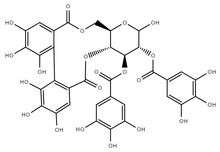
| |
| Names | |
|---|---|
| Systematic IUPAC name (11aR,13Ξ,14R,15S,15aR)-2,3,4,5,6,7,13-Heptahydroxy-9,17-dioxo-9,11,11a,13,14,15,15a,17-octahydrodibenzopyranodioxacycloundecine-14,15-diyl bis(3,4,5-trihydroxybenzoate) | |
| Other names 1-desgalloyleugeniin | |
| Identifiers | |
| CAS Number | |
| 3D model (JSmol) | |
| ChEBI | |
| ChEMBL | |
| ChemSpider | |
| KEGG | |
| PubChem CID | |
| CompTox Dashboard (EPA) | |
InChI
| |
SMILES
| |
| Properties | |
| Chemical formula | C34H26O22 |
| Molar mass | 786.56 g/mol |
| Except where otherwise noted, data are given for materials in their standard state (at 25 °C , 100 kPa). Infobox references | |
Tellimagrandin I is an ellagitannin found in plants, such as Cornus canadensis, Eucalyptus globulus, Melaleuca styphelioides, Rosa rugosa, and walnut. It is composed of two galloyl and one hexahydroxydiphenyl groups bound to a glucose residue. It differs from Tellimagrandin II only by a hydroxyl group instead of a third galloyl group. It is also structurally similar to punigluconin and pedunculagin, two more ellagitannin monomers.
Tellimagrandin I has been shown to restore antioxidant enzyme activity in glucose- and oxalate-challenged rat cells and affects Cu(II)- and Fe(II)-dependent DNA strand breaks. It has hepatoprotective effects on carbon tetrachloride- and d-galactosamine-stressed HepG2 cells and enhances peroxisomal fatty acid beta-oxidation in liver, increasing mRNA expression of PPAR alpha, ACOX1, and CPT1A. It enhances gap junction communication and reduces tumor phenotype in HeLa cells and inhibits invasion of HSV-1 and HCV similar to eugeniin and casuarictin.
See also
References
- Ganesan D, Al-Sayed E, Albert A, Paul E, Singab AN, Govindan Sadasivam S, Saso L (21 Jun 2017). "Antioxidant activity of phenolic compounds from extracts of Eucalyptus globulus and Melaleuca styphelioides and their protective role on D-glucose-induced hyperglycemic stress and oxalate stress in NRK-49Fcells". Nat Prod Res. 32 (11): 1274–1280. doi:10.1080/14786419.2017.1343324. PMID 28637361. S2CID 4705598.
- Yi ZC, Liu YZ, Li HX, Wang Z (Jun 2009). "Chebulinic acid and tellimagrandin I inhibit DNA strand breaks by hydroquinone/Cu(II) and H(2)O(2)/Cu(II), but potentiate DNA strand breaks by H(2)O(2)/Fe(II)". Toxicol in Vitro. 23 (4): 667–673. doi:10.1016/j.tiv.2009.03.009. PMID 19328845.
- Yi ZC, Liu YZ, Li HX, Wang Z (Apr 2009). "Prooxidant action of chebulinic acid and tellimagrandin I: causing copper-dependent DNA strand breaks". Toxicology in Vitro. 23 (3): 425–431. doi:10.1016/j.tiv.2009.01.012. PMID 19344683.
- Al-Sayed E, Esmat A (Sep 2016). "Hepatoprotective and antioxidant effect of ellagitannins and galloyl esters isolated from Melaleuca styphelioides on carbon tetrachloride-induced hepatotoxicity in HepG2 cells". Pharm Biol. 54 (9): 1727–1735. doi:10.3109/13880209.2015.1125933. PMID 26731241.
- Shimoda H, Tanaka J, Kikuchi M, Fukuda T, Ito H, Hatano T, Yoshida T (25 Jun 2008). "Walnut polyphenols prevent liver damage induced by carbon tetrachloride and d-galactosamine: hepatoprotective hydrolyzable tannins in the kernel pellicles of walnut". J Agric Food Chem. 56 (12): 4444–4449. doi:10.1021/jf8002174. PMID 18494495.
- Shimoda H, Tanaka J, Kikuchi M, Fukuda T, Ito H, Hatano T, Yoshida T (11 Mar 2009). "Effect of polyphenol-rich extract from walnut on diet-induced hypertriglyceridemia in mice via enhancement of fatty acid oxidation in the liver". J Agric Food Chem. 57 (5): 1786–1792. doi:10.1021/jf803441c. PMID 19256553.
- Yi ZC, Liu YZ, Li HX, Yin Y, Zhuang FY, Fan YB, Wang Z (8 Oct 2006). "Tellimagrandin I enhances gap junctional communication and attenuates the tumor phenotype of human cervical carcinoma HeLa cells in vitro". Cancer Lett. 242 (1): 77–87. doi:10.1016/j.canlet.2005.10.044. PMID 16338066.
- Lavoie S, Côté I, Pichette A, Gauthier C, Ouellet M, Nagau-Lavoie F, Mshvildadze V, Legault J (22 Feb 2017). "Chemical composition and anti-herpes simplex virus type 1 (HSV-1) activity of extracts from Cornus canadensis". BMC Complement Altern Med. 17 (1): 123. doi:10.1186/s12906-017-1618-2. PMC 5322616. PMID 28228101.
- Tamura S, Yang GM, Yasueda N, Matsuura Y, Komoda Y, Murakami N (2010). "Tellimagrandin I, HCV invasion inhibitor from Rosae Rugosae Flos". Bioorg Med Chem Lett. 20 (5): 1598–1600. doi:10.1016/j.bmcl.2010.01.084. PMID 20144544.
This article about an aromatic compound is a stub. You can help Misplaced Pages by expanding it. |